The Three Colours Trilogy (1993-1994): the legacy of a great one | el legado de un grande
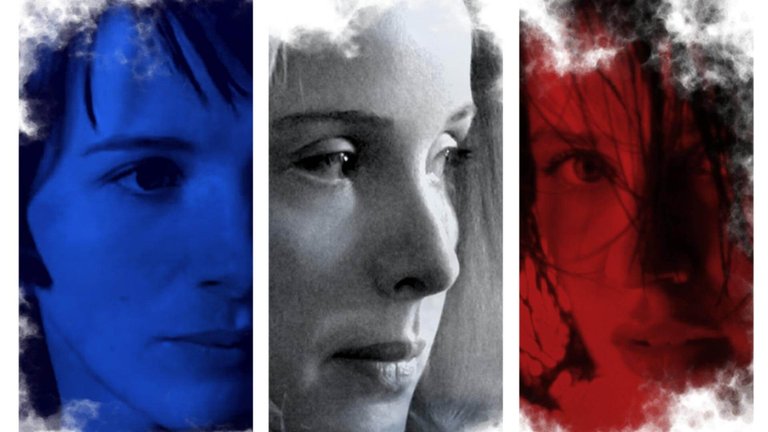
Dirigida por Krzysztof Kieślowski
I have finally settled an outstanding debt with European cinema and this week I sat down to watch the acclaimed trilogy of The Three Colors, a series of films directed by Krzysztof Kieślowski and co-written by him with Krzysztof Piesiewicz, which gave a lot of value speak at the beginning of the nineties and which are considered the highest point in the Polish director's career. The colors referred to in the title are both the names of the films and the colors present on the French flag: Blue (Bleu), White (Blanc) and Red (Rouge).
Finalmente he saldado una deuda pendiente con el cine europeo y es que esta semana me senté a ver la aclamada trilogía de Los Tres Colores, una serie de films dirigidos por Krzysztof Kieślowski y co escritas por él junto a Krzysztof Piesiewicz, que dieron mucho de qué hablar a principio de los noventa y que están consideradas como el punto más elevado en la carrera del director polaco. Los colores a los que hace referencia el título son tanto los nombres de las películas como los colores presentes en la bandera francesa: Azul (Bleu), Blanco (Blanc) y Rojo (Rouge).
Three Colours: Bleu
Released in 1993, the first installment of the trilogy is a dramatic film that focuses on Julie (the extraordinary Juliette Binoche), a woman who loses her husband Patrice and her young daughter, Anna, in a tragic car accident. Patrice was a great musical composer and after his death tributes are paid to him and there is a lot of talk about a possible work that he left unfinished. After spending some time in the hospital, Julie recovers and wants to rebuild her life by burning all the bridges: she puts her house and all her assets up for sale. She wants to go somewhere where no one knows her and lead a solitary and anonymous life, but Olivier, her late husband's assistant, tries to rescue her from that isolation not only with the excuse of reviewing Patrice's work but also because he has a romantic interest in her, he always has. The direction is very good and the music even better, with those interventions that seem to occur inside Julie's mind, as if she were the one listening to the notes that accompany some scenes. This first story has to do with music, love, the pain of loss, wanting to start over, but the central theme is liberty, the first of the three French values (liberty, equality, fraternity) only dressed of tragedy because Julie achieves that individual freedom after tragically losing her family.
Estrenada en 1993, la primera entrega de la trilogía es una película dramática que se centra en Julie (la extraordinaria Juliette Binoche), una mujer que pierde a su marido Patrice y a su pequeña hija, Anna, en un trágico accidente de tránsito. Patrice fue un gran compositor musical y tras su muerte se le rinden homenajes y se habla mucho de una posible obra que haya dejado inconclusa. Después de pasar un tiempo en el hospital, Julie se recupera y desea rehacer su vida quemando todos los puentes: pone en venta su casa y todos sus bienes. Quiere marcharse a algún lugar en el que nadie la conozca y llevar una vida solitaria y anónima, pero Olivier, el ayudante de su difunto esposo, intenta rescatarla de ese aislamiento no sólo con la excusa de revisar el trabajo de Patrice sino también porque tiene un interés romántico en ella, siempre lo ha tenido. La dirección es muy buena y la música aún mejor, con esas intervenciones que parecen producirse dentro de la mente de Julie, como si fuese ella quien escucha las notas que acompañan algunas escenas. Esta primera historia tiene que ver con la música, el amor, el dolor de la pérdida, el querer comenzar de nuevo, pero el tema central es la libertad, el primero de los tres valores franceses (libertad, igualdad, fraternida) sólo que vestido de tragedia pues Julie alcanza esa libertad individual tras perder trágicamente a su familia.

The second part of the trilogy, released a year later, is a somewhat strange story that focuses on the second value mentioned, equality, but it also does so from a twisted or distant perspective, and it's the only one of the three that is not made entirely in French but has parts spoken in Polish.
La segunda parte de la trilogía, estrenada un año más tarde es una historia algo extraña que se centra en el segundo valor mencionado, la igualdad, pero lo hace también desde una perspectiva retorcida o lejana, y es la única de las tres que no está hecha enteramente en francés sino que tiene partes habladas en polaco.
Three Colours: Blanc
This second part seems, at first glance, more friendly and gives the impression, at times, of being a comedy. But it's not so much. Or yes, perhaps it can be considered a sad comedy because the protagonist goes through situations so crazy that they could be funny if they weren't so sad. Maybe for some they do both. Karol (Zbigniew Zamachowski) is a Polish citizen who begins the film in the middle of a divorce suit imposed by his wife Dominique (the beautiful and talented Julie Delpy of Before Sunset), who claims the non-consummation of the marriage as the reason for breaking up. For some reason Karol has not been able to satisfy his wife sexually after getting married even though they had been intimate before getting married. The situation is humiliating for Karol not only because of the sexual implications but because he's tried in Paris, far from his native Poland, in French, a language that he doesn't fully understand, and in solitude, because his only link with France is his recent found and lost wife. As expected, things are going worse and worse for Karol, from wandering the Parisian streets cold and without money to an escape to Poland worthy of The Count of Monte Cristo, the misadventures of this young Pole take him to a place in the who, having nothing to lose, begins to plot the means to get Dominique back and will stop at nothing to make her come look for him in Poland.
Esta segunda parte parece, a primera vista, más amable y da la impresión, por momentos, de tratarse de una comedia. Pero no lo es tanto. O sí, quizás pueda ser considerada una comedia triste porque el protagonista pasa por situaciones tan disparatadas que podrían dar risa si no dieran tanta pena. Quizás a algunos les provoquen ambas cosas. Karol (Zbigniew Zamachowski) es un ciudadano polaco que inicia la película en medio de una demanda de divorcio impuesta por su mujer Dominique (la hermosa y talentosa Julie Delpy de Before Sunset), quien alega como motivo de ruptura la no consumación del matrimonio. Por alguna razón Karol no ha podido satisfacer sexualmente a su esposa después de haberse casado aunque hubieran intimado antes de contraer nupcias. La situación es humillante para Karol no sólo por las implicaciones sexuales sino porque es juzgado en París, lejos de su Polonia natal, en francés, una lengua que no entiende bien del todo, y en soledad, porque su único vínculo con Francia es su recién encontrada y perdida esposa. Como es de esperarse a Karol las cosas le salen cada vez peor, desde vagar por las calles parisinas con frío y sin dinero hasta una huida a Polonia digna de El Conde de Montecristo, las desventuras de este joven polaco lo van llevando a un lugar del que, por no tener nada que perder, comienza a urdir los medios para recuperar a Dominique y no se detendrá ante nada para hacer que ella venga a buscarlo a Polonia.
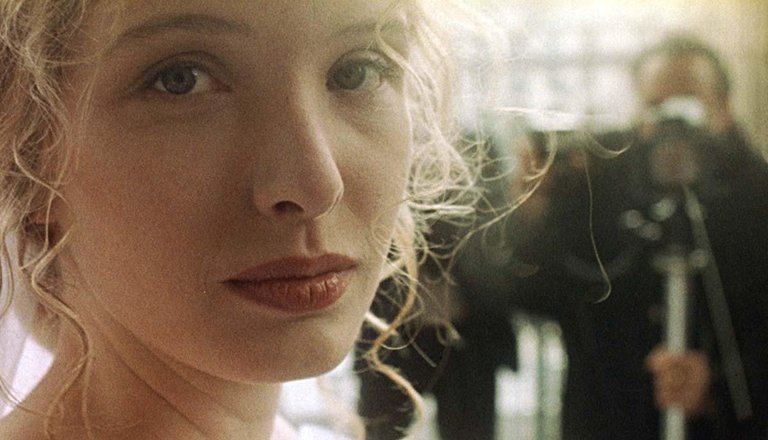
The things that Karol does are best not revealed and the ending - perhaps the most surprising of the trilogy - is a great closure for a second part that seemed to be heading towards a sad and pathetic destiny (because of the theme, not because of the quality of the film). The truth is that at no time did I suspect that the film would end that way and I really enjoyed the parallels and symmetry of some of the fates.
Las cosas que hace Karol es mejor no revelarlas y el final - acaso el más sorpresivo de la trilogía - es un gran cierre para una segunda parte que parecía dirigirse hacia un destino triste y patético (por el tema, no por la calidad de la película). La verdad es que en ningún momento sospeché que la cinta terminaría de esa manera y disfruté mucho los paralelismos y la simetría de algunos destinos.
Three Colours: Rouge
The third installment is definitely the best of the trilogy and probably the best film of its director. The direction is incredible, the photography is exquisite, the script too and it moves a bit in the field between the other two. It's not a sad comedy, nor a tragedy, it's a drama that connects several themes and several characters in whose destinies parallelisms and that game of mirrors that we sometimes find in reality are also present in which everything seems like a repetition. Valentine (a wonderful Irène Jacob) is a young student who lives in Geneva and works as an advertising and catwalk model. She's not a Top Model who lives in luxury and celebrity, but modeling is for her a job like any other. One day she runs over a dog and when she takes it to its owner's house she meets a retired judge who is spying on his neighbors' telephone conversations. The judge is a somewhat unsociable character who for some represents God, that great judge turned observer, but who does not intervene in the destiny of his creatures. At first, Valentine condemns the old man and rejects him for his interference in the lives of others, but little by little she gets to know him better and they come to have great trust in each other. There are other stories that are mixed with this one, such as Valentine's distant and absent boyfriend, or the love relationship between her neighbor and another girl that also functions as a mirror reflection of the judge's past.
La tercera entrega es definitivamente la mejor de la trilogía y probablemente la mejor película de su director. La dirección es increíble, la fotografía es exquisita, el guión también y se mueve un poco en el terreno en medio de las otras dos. No es una comedia triste, ni una tragedia, es un drama que conecta varios temas y varios personajes en cuyos destinos también están presentes los paralelismos y ese juego de espejos que a veces nos encontramos en la realidad en la que todo parece una repetición. Valentine (una maravillosa Irène Jacob) es una joven estudiante que vive en Ginebra y trabaja como modelo publicitaria y de pasarela. No es una Top Model que viva en medio de lujos y celebridad, sino que el modelaje es para ella un trabajo como cualquier otro. Un día atropella un perro y cuando lo lleva a casa de su dueño se encuentra con un juez jubilado que espía las conversaciones telefónicas de sus vecinos. El juez es un personaje algo huraño que para algunos representa a Dios, ese gran juez convertido en obervador, pero que no interviene en el destino de sus criaturas. Al principio, Valentine condena al anciano y lo rechaza por su intromisión en la vida de los demás, pero poco a poco lo va conociendo mejor y llegan a tener una gran confianza el uno en el otro. Hay otras historias que se mezclan con esta, como el novio distante y ausente de Valentine, o la relación amorosa de un vecino de ella con otra chica que funciona también como reflejo especular del pasado del juez.
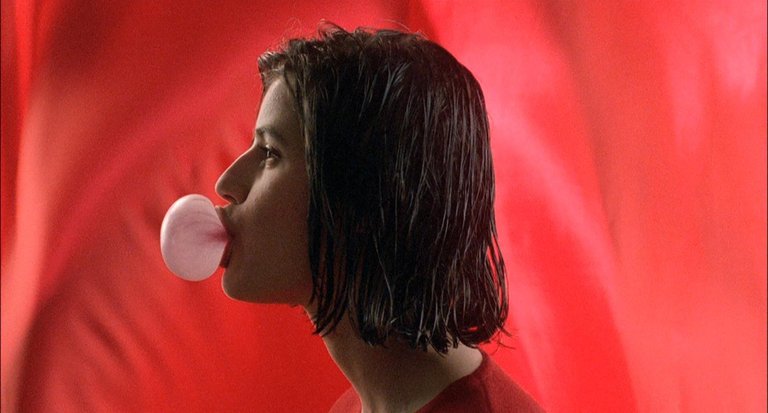
The way in which Krzysztof Kieślowski intersects the stories is wonderful. Not so much the three films (which yes, they converge in the final sequence of the last one) but within each one of them. In a scene focused on a character we see someone passing by in the distance who later also turns out to be relevant to the story. This forces the viewer to pay attention to the details, the connections, those small signs that sometimes are nothing more than a pack of cigarettes or a car parked in the distance.
Es maravillosa la forma en que Krzysztof Kieślowski va cruzando las historias. No tanto las tres películas (que sí, convergen en la secuencia final de la última) sino dentro de cada una de ellas. En una escena centrada en un personaje vemos pasar, a lo lejos, a alguien que luego resulta también relevante para la historia. Eso obliga al espectador a estar atento a los detalles, las conexiones, esas pequeñas señales que a veces no son más que una cajetilla de cigarros o un auto aparcado a lo lejos.
But there's also the photography and the aesthetic treatment of the scenes. The colors Blue, White and Red are not only present in the titles and in the representation of French values but they make an appearance throughout each of the stories. In the first, there's a blue room that is important, a crystal lamp of the same color and an atmosphere in those tones. The only woman dressed as a bride is Julie Delpy, who appears in the second film which also has a colder and whiter aesthetic. And in the third installment, red abounds: a vehicle, chairs, plates, a wall, a room and the unforgettable and enormous poster with Valentine's face in profile. All of this, added to the themes raised in each of the three films (love, sex, grief, death, old age, voyeurism, youth, freedom, infidelity, revenge, loneliness, among many others) have turned this trilogy into a work of cult and Krzysztof Kieślowski into one of the names that must be reviewed when talking about the cinema of the eighties and nineties. For some, the best of the director of A Short Film About Killing is his Decalogue, for others the unforgettable La Double Vie de Véronique, also starring Irène Jacob, but most agree that the best of his legacy is this trilogy, the last films he made before he died in 1996, had you heard of this Polish director? Did you know about the existence of these movies? Have you seen them? I read you in the comments.
Pero además están la fotografía y el tratamiento estético de las escenas. Los colores Azul, Blanco y Rojo, no están presentes solamente en los títulos y en la representación de los valores franceses sino que hacen acto de presencia a lo largo de cada una de las historias. En la primera, hay una habitación azul que es importante, una lámpara de cristales del mismo color y una atmósfera en esos tonos. La única mujer vestida de novia es Julie Delpy, quien aparece en la segunda película que también tiene una estética más fría y blanca. Y en la tercera entrega abunda el rojo: un vehículo, sillas, platos, una pared, una habitación y el inolvidable y enorme cartel con el rostro de Valentine de perfil. Todo ello, sumado a los temas planteados en cada uno de los tres films (amor, sexo, duelo, muerte, vejez, voyeurismo, juventud, libertad, infidelidad, venganza, soledad, entre muchos otros) han convertido esta trilogía en una obra de culto y a Krzysztof Kieślowski en uno de los nombres que hay que revisar cuando se habla del cine de los años ochenta y noventa. Para algunos, lo mejor del director de A Short Film About Killing es su Decálogo, para otros la inolvidable La Double Vie de Véronique, protagonizada también por Irène Jacob, pero la mayoría coincide en que lo mejor de su legado es esta trilogía, las últimas películas que realizó antes de fallecer en 1996, ¿habían oído hablar de este director polaco? ¿sabían de la existencia de estas películas? ¿las han visto? Los leo en los comentarios.
Reseñado por @cristiancaicedo
Other posts that may interest you | Otros posts que pueden interesarte:
  |
|---|
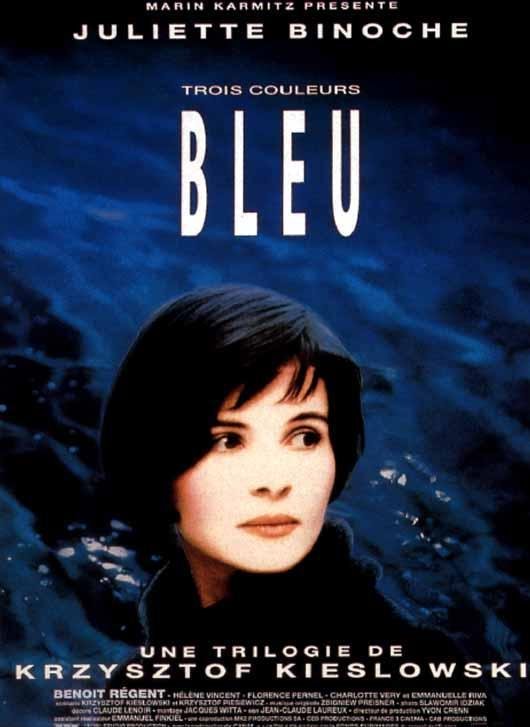
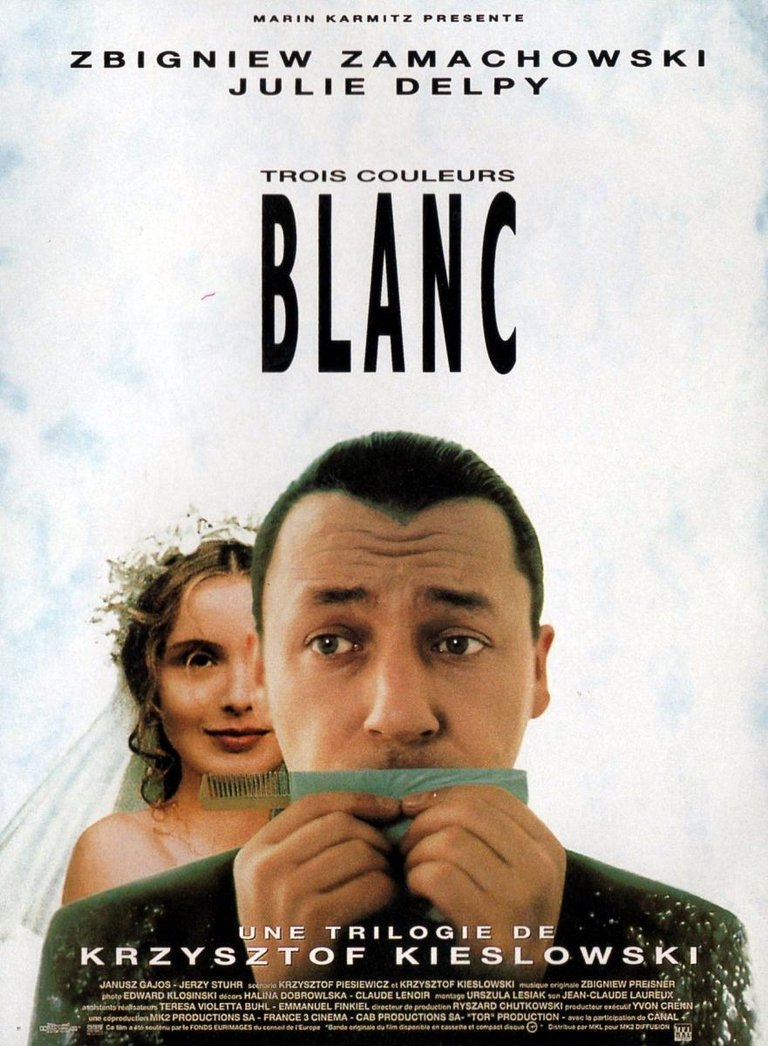

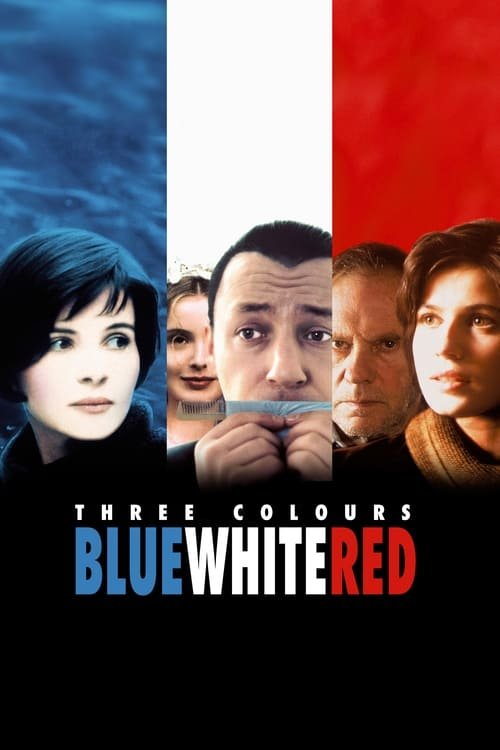
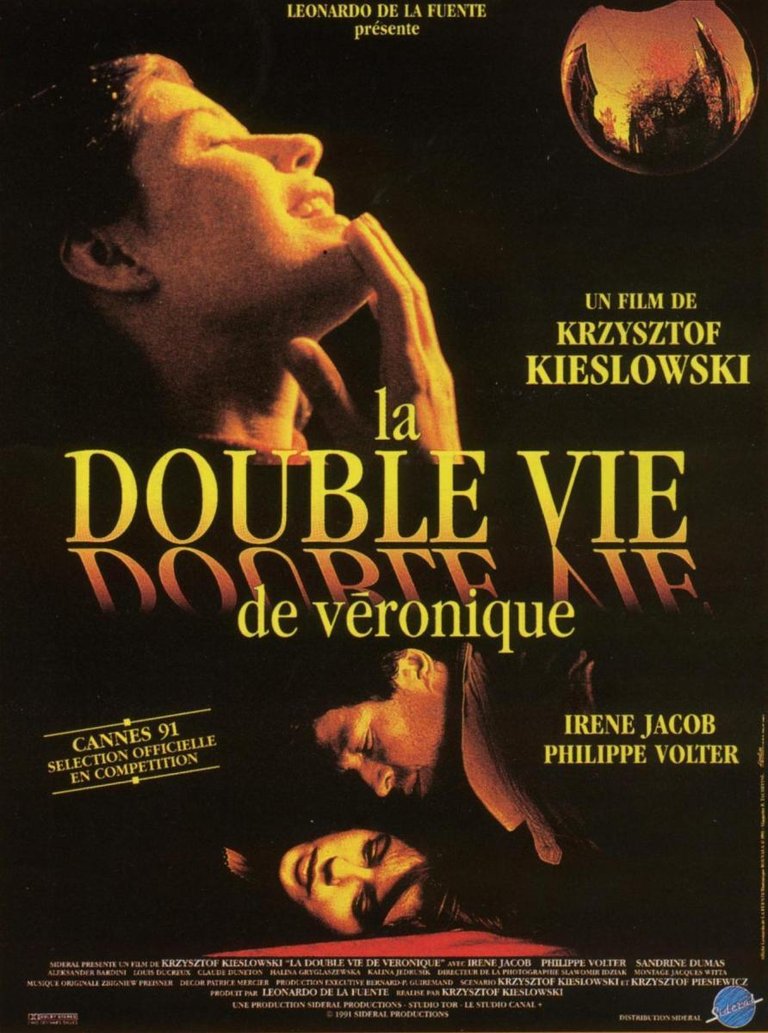
The trilogy that this film has is very surprising, I really like that they always relate it to the previous one so that the essence is not lost, honestly I have not seen any of the 3, but if I notice that it has a very entertaining story, I will put it on my list to watch when I want to browse through old movies, it is a moment that is used to enjoy them to the fullest.